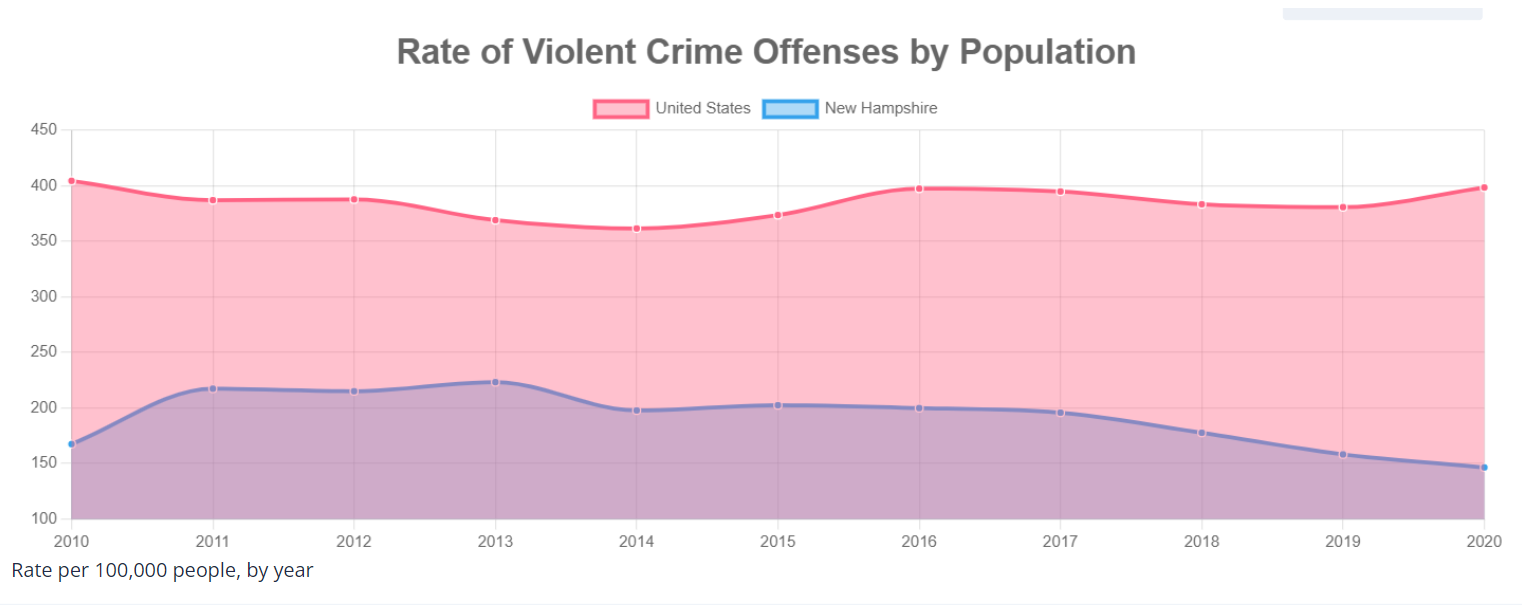FBI: Violent crime, property crime in NH decreased in 2021
FBI statistics released Wednesday show that fewer crimes – both violent and property crimes – were reported by New Hampshire law enforcement in 2021 than the previous year.


FBI statistics released Wednesday show that fewer crimes – both violent and property crimes – were reported by New Hampshire law enforcement in 2021 than the previous year.
The 2021 statistics also showed something hasn’t changed – when it comes to violent crime in New Hampshire, the majority of offenders are white, male and someone the victim knows. The majority of victims are female. In the case of murder, rape and aggravated assault, by far the least safe place to be is in your own home.
New Hampshire agencies reported 1,585 violent crime incidents, and 1,691 offenses, to the FBI’s National Incident-Based Reporting System last year (an incident can include more than one offense). The 208 agencies that reported represent 96 percent of the state’s population (12 law enforcement agencies didn’t submit data to the FBI in 2021).
Reported property crime in New Hampshire in 2021, included 13,491 property-crime incidents, and 13,491 offenses.
In 2020, fewer N.H. law enforcement agencies reported more crimes – 193 agencies reported 1,760 violent crime incidents, and 1,875 offenses, as well as 14,571 property crimes and 14,613 property crime offenses.

The FBI categorizes violent crime as murder, rape, robbery and aggravated assault; the property crime categories are arson, burglary, larceny/theft and motor vehicle theft.
Nationally, violent and property crime remained consistent in 2021 when compared with 2020, the FBI said. While robberies were down, the other three violent crime categories increased slightly. Property crime showed similar slight changes. The FBI said the changes aren’t significant enough to consider them trends.
FBI year-over-year statistics show violent crime in New Hampshire well below the national rate. In New Hampshire in 2020, there were 146.5 violent crimes per 100,000 in population, compared to 398.5 nationally. But the agency cautions against making regional comparisons.
“It’s important to consider the various factors that lead to crime activity and crime reporting in a community before interpreting the data,” the FBI says on its Crime Data Explorer website. “Without these considerations the available data can be deceiving. Factors to consider include population size and density, economic conditions, employment rates, prosecutorial, judicial, and correctional policies, administrative and investigative emphases of law enforcement, citizens’ attitudes toward crime and policing, and the effective strength of the police force.”
Here’s a look at New Hampshire crime in 2021, as reported to the FBI. (“Unknown” frequently means that statistic wasn’t recorded by the reporting law enforcement agency):
Homicide
There were 13 reported homicides by 16 offenders in New Hampshire in 2021.
- 6 offenders were 30-39 years old, 3 each were in the 10-19 and 40-49 categories, 2 were 20-29, 1 was 50-59, 1 was 70-79
- 14 offenders were male, 2 female
- 14 offenders were white, 1 Black, 1 Asian-American
- 6 victims were 20-29, 2 each 10-19, 30-39, 70-79; 1 each was 50-59, 60-69
- 9 victims were male, 5 female
- 12 victims were white, 2 Black
- 10 homicides were in a residence, 1 was in a motel/hotel, 1 in a park/playground, 1 in an unknown location
- 3 victims were spouses, 2 boyfriend/girlfriend, 2 children, 2 acquaintances, 3 relationship was unknown
- In 9 the weapon was a handgun or other type of firearm, other weapons were blunt object, asphyxiation, knife or sharp instrument
Rape
There were 610 rapes reported in New Hampshire in 2021.
- 164 offenders were 10-19, 127 20-29, 86 30-39, the rest ranged through all age groups from 0-9 (10) to 80-89 (1), with the ages of 21 offenders unknown
- 291 victims were 10-19, 122 20-29, the rest ranged through all age groups from 0-9 age group (60 victims) to the 80-89 age group (3 victims)
- 511 of the offenders were male, 23 female, 10 gender unknown
- 547 of the victims were female, 61 male, 2 gender unknown
- 452 of the offenders were white, 54 of unknown race, 31 Black, 5 Asian, 1 American Indian
- 547 of the victims were white, 42 race unknown, 17 Black, 4 Asian
- 385 of the rapes took place in a residence, 45 in an unknown place, 43 public or government building, 25 school, 21 hotel/motel
- 105 were by an acquaintance, 68 friend, 60 person in a dating relationship, 60 someone known to the victim that doesn’t fit the other categories, 41 child of the offender or in the offender’s care; as well as several other categories.
Robbery
There were 181 robberies by 190 offenders, with 190 victims. A robbery theft using force or a weapon.
- 116 offenders were 20-39, 23 age unknown and the rest ranged from the 10-19 age group to the 60-69 group.
- 53 victims were 30-39, 52 were 20-29, 32 50-59, 20 10-19, 18 40-49, 13 60-69; 1 each in the 0-9 and 70-79 age groups
- 144 of the offenders were male, 39 female, 7 unknown
- 118 of the victims were male, 72 female
- 35 were at convenience stores, 33 residences, 28 department/discount stores, 28 highway/alley/street/sidewalk, 15 unknown
- In 70, the offender was a stranger to the victim, 38 were an acquaintance, 22 someone otherwise known to the victim, 9 friend, 55 relationship unknown
- 92 of the offenders used “personal weapons” in the robbery (hand, fist, feet, etc.), 23 used a handgun, 10 another type of firearm, 22 a knife or other type of cutting instrument, with other weapons unknown.
Aggravated Assault
There were 791 aggravated assault incidents, and 886 offenses, reported.
- 239 of the offenders were 20-29, 227 were 30-39, 105 were 40-49, with the rest spread across other age groups.
- 233 victims were 30-39, 231 were 20-29, 120 40-49, with the rest spread across other age groups.
- 661 of the offenders were male, 124 female, 8 unknown
- 451 of the victims were female, 421 male, 14 unknown
- 647 of the offenders were white, 111 Black, 29 unknown, 5 Asian, 1 American Indian
- 775 of the victims were white, 66 Black, 5 Asian, 1 American Indian, 39 unknown
- 497 of the assaults happened in a residence, 173 highway/alley/street/sidewalk, with 25 other locations listed for the rest, as well as 30 unknown
- 173 were a boyfriend/girlfriend of the victim, 132 an acquaintance, 104 stranger, with the rest across 20 other types of relationship include child of the offender (53), spouse (51) and parent (31).
- 299 used personal weapons (hand, fist, feet, etc.) in the assault; 156 used a knife or cutting instrument; 147 used a handgun, rifle, shotgun or another type of firearm; 69 used asphyxiation; seven other weapons also listed.
Other offenses that accompanied the assault were destruction/damage/vandalism of property, 86; simple assault, 47; kidnapping/abduction, 31; weapon law violations, 30; with 18 other offenses listed.
Property Crime
Of the 13,491 property crimes reported to the FBI by N.H. law enforcement in 2021, larceny/theft was the most common, followed by burglary, motor vehicle theft and arson. Overall, there were 7,016 reported offenders (many responsible for more than one crime). The majority of offenders were male, and, unlike violent crime, most were strangers to their victims. Aside from arson, a property crime was overwhelmingly more likely to happen at a residence than anywhere else.
Some statistics are:
- 11,534 larceny incidents reported, 4,210 at a residence, second was department/discount store, 1,817
- 957 burglaries, 759 at a residence, second was commercial/office building, 73.
- 892 motor vehicle thefts, 396 stolen from a residence; 133 from highway/alley/street/sidewalk
- 108 reported arsons, 39 involving a residence, 36 a highway/alley/street/sidewalk
- 4,320 of known property crime offenders were male – larceny/theft, 3,448; burglary, 407; motor vehicle theft, 424; arson, 41.
- 2,369 of known property crime offenders were female – larceny/theft, 2,088; motor vehicle theft, 155; burglary, 113; arson, 13.
- 1,462 overall offenders were strangers to the victim, with relationship unknown second at 847, and 489 acquaintance, with offenders in 19 other relationship categories.
Full Statistics Available
Full statistics for New Hampshire, as well as national statistics, can be found at the FBI’s Crime Data Explorer.
The FBI cautions about comparing statistics from regions or years, because of variations in how crime is recorded by different law enforcement agencies, as well as how it’s reported to the FBI. It also points out that the statistics on its Crime Data Explorer represent reported crime, and are not an “exhaustive report of all crime that occurs.”





